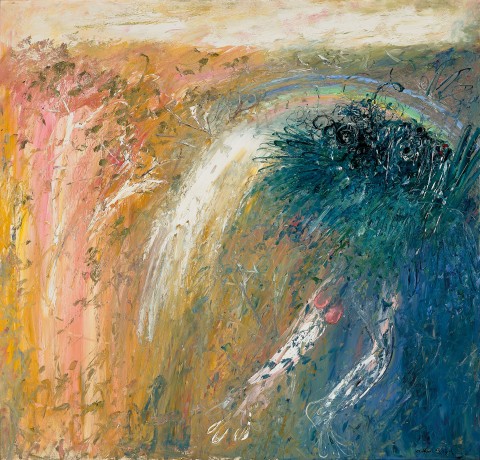NEBUCHADNEZZAR, RAINBOW AND WATERFALL, 1967
ARTHUR BOYD
oil on canvas
107.5 x 112.5 cm
signed lower right: Arthur Boyd
bears inscription verso: 12
Rudy Komon Gallery, Sydney (stock no. 1974)
Private collection, Sydney
Savill Galleries, Sydney (label attached verso)
Private collection, Sydney
Sotheby’s, Sydney, 12 May 2014, lot 77
Private collection, Sydney
Arthur Boyd, Bonython Art Gallery, Sydney, 8 – 24 April 1968, Australian Galleries, Melbourne, 25 June – 5 July 1968, cat. 22
Four Australian Modern Masters: Arthur Boyd, Sidney Nolan, Brett Whiteley, Fred Williams, Savill Galleries, Sydney, 11 November – 6 December 1988, cat. 7 (illus. in exhibition catalogue, as ’Nebuchadnezzar and Rainbow 1968’)
‘I’d like to feel that through my work there is a possibility of making a contribution to a social progression or enlightenment. It would be nice if the creative effort or impulse was connected with a conscious contribution to society, a sort of duty of service.’1
According to the Old Testament, Nebuchadnezzar, king of ancient Babylon (602 – 562 BCE), was a successful ruler who fell from grace for placing his own self-aggrandisement before God. As punishment for his pride and arrogance, he thus lost his sanity and was banished into the wilderness for seven years where he underwent various trials and tribulations: ‘...his heart was made like the beasts, and his dwelling was with the wild asses: they fed him with grass like oxen, and his body was wet with the dew of heaven; til he knew that the most high God ruled in the kingdom of men, and that he appointeth over it whomsoever he will.’2 Although the Book of Daniel has provided inspiration to the visual arts for centuries from the medieval façade reliefs of Notre Dame La Grande, Poitiers to the Romantic prints of visionary William Blake, no painter has arguably ever devoted him or herself more fully to imagining the degenerative experiences of Nebuchadnezzar in the wilderness than Australian modernist, Arthur Boyd.
Imbuing his king with Lear-like characteristics, Boyd embarked upon this impressive Nebuchadnezzar series in 1966 to illustrate a text on the theme by the scholar Thomas S.R. Boase (who subsequently published 34 of the works in his dedicated tome in 1974).3 Characterised by its frenzied energy, vivid colour and profound symbolic permutations, the series still remains one of the artist’s most sustained, encompassing more than a hundred works and featuring some of the most sumptuously executed paintings of his career. Elaborating upon the appeal of the theme for the artist, Boase suggests: ‘Here is a subject that leads immediately into Boyd’s preoccupation in many other works with the fusion between man and natural forces, the involvement of man and beast... Other echoes link with Boyd’s own symbolism, the sinister dark birds, the gentle mourning dog. Behind the figures there are traces of the Australian landscape of his early inspiration. But if these works are enriched with such references, the myth is newly and freshly created, a second Daniel come to judgment [sic.] our own contemporary obscure and secret impulses.’4
Given the artist’s renowned social conscience, indeed it is perhaps not coincidental that his Nebuchadnezzar series was produced at the height of the Vietnam War when audiences internationally were assailed with images in the mass media of cruel dictatorial regimes: villages incinerated, men and women tortured, children screaming from the pain of napalm. As one author notes, ‘self-immolations in protest actually took place on Hampstead Heath near Boyd’s house... and once more, a biblical subject by him was seen to be an allegory of the descent of humanity in a conflicted world.’5
In Nebuchadnezzar, Rainbow and Waterfall, 1967, the king ablaze in golden flames has become barely distinguishable from the dry Australian bushland and musk pink waterfall – thus inextricably fused with the natural world in a manner that unmistakably foreshadows the artist’s interpretations of the Narcissus myth a decade later. As with other iterations, including Nebuchadnezzar Running in the Rain and Lion’s Head in a Cave and Rainbow6, here Boyd notably includes the motif of a rainbow, perhaps as a symbol of hope or sign of God’s covenant – or conversely, to denote the fruitless pursuit of an illusory aim (the ultimate downfall of his biblical protagonist). Either way, like the finest of Boyd’s Nebuchadnezzar achievements, the present offers an empathetic and emotive response to a harsh tale of moral instruction, giving compelling form to ‘…good and evil; things elemental and mysterious, things intensely human and vulnerable.’7
1. Arthur Boyd, cited at https://www.bundanon.com.au/collection/exhibitions-page/active-witness/
2. Boase, T.S., Nebuchadnezzar, Thames and Hudson, London, 1972, p. 20
3. Pearce, B., Arthur Boyd Retrospective, Art Gallery of New South Wales, Sydney, 1993, p. 26
4. Boase, op. cit., p.42
5. Pearce, op. cit.
6. See Boase, op. cit., plates 22 and 40
7. Oliver, C., ‘A Welcome to Arthur Boyd’ in Retrospective Exhibition of Paintings, Drawings and Other Works by Arthur Boyd, ex.cat., Richard Demarco Gallery, Edinburgh, Scotland, 1969, n.p.
VERONICA ANGELATOS
